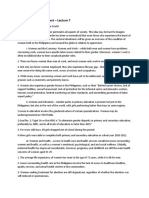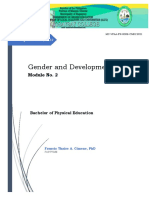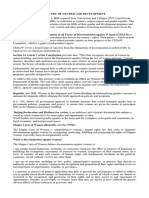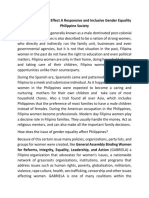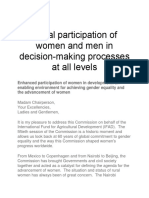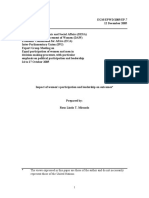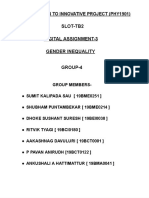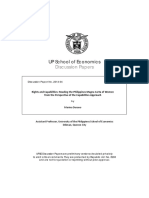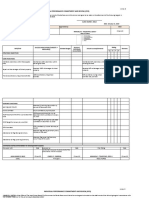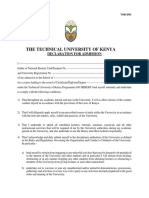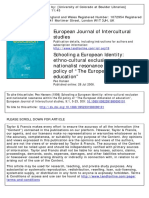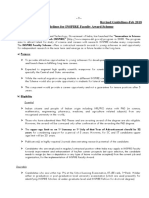5th Higher Education Summit on Gender Issues
Dr. Rhodora T. Masilang-Bucoy
Chair, ASEAN Ministerial Meeting on Women
Chair, Philippine Commission on Women
Keynote Speech
November 29, 2017
Introduction
I would like to thank the Commission on Higher Education Chair, Dr. Patricia Licuanan,
the Commission on Higher Education Gender and Development Focal Point Committee
Chair, Atty Yadao Sison and the Technical Panel on Gender and Women’s Studies Head,
my friend and mentor Dr. Carol Sobritchea, for inviting me to this Summit on Gender and
Higher Education. The Philippine Commission on Women and the Commission on Higher
Education have been partners (“in crime”) in conducting this summit since 2013. We just
closed the two-day ASEAN Summit on Gender Mainstreaming in Higher Education
yesterday. Today, we hold this equally important Higher Education Summit on Gender
Issues – the 5th already! I would like to recognize the university presidents, academic heads
and GAD Focals of higher education institutions, who are here today to express their
commitment to promote gender equality and women’s empowerment in the academe and for
their proactive response to the CHED MEMO No. 1 series of 2015 calling for gender
mainstreaming in the education sector.
I am happy to speak to fellow educators belonging to the higher education institutions.
As an educator myself, I firmly believe in the important role of education in social
transformation. My own personal narrative exemplifies how access to education and
scholarship empowered me to become who I am today, an accomplished feminist scholar
and activist.
1
� Through our commitment to academic excellence and democratic values, respect for
human rights, diversity, social justice and service for the people, we can collectively shape
the minds and hearts of the future leaders of this nation.
Given the transformative role of education among other social institutions that play
varying roles in the socialization of the youth, I will focus my talk today on how higher
education institutions can become an instrument to achieve gender equality and the
empowerment of all women and girls. These are twin goals we are committed to implement
along with the other Sustainable Development Goals and the newly adopted Philippine
Development Plan of 2017-2022. Gender equality and women’s empowerment are
aspirations all states have pledged to achieve when they signed the 2030 Agenda for
Sustainable Development as well as the earlier treaties and agreements like CEDAW and
the Beijing Platform of Action for Women in 1995. Recently, as we hosted the ASEAN
Summit, the member states of ASEAN adopted declarations which enunciated this vision of
inclusive growth, people-oriented, people-centered development.
Why should we remain committed to pursuing gender equality and empowerment of all
women and girls? Why is there still a need for this advocacy? Isn’t the Philippines the only
country in Asia that have narrowed the gender gap? In 2013, the Philippines ranked 5th in
the Global Gender GAP report of the World Economic Forum. In 2015 and 2016, we held the
7th position. But this year, we slipped to No. 10, the lowest rank ever since 2006. Remaining
in the top ten in the Global Gender Gap ranking evinced our significant strides in almost
closing the gap in education and improving gender disparities in health, economic
opportunity and participation, and political empowerment.
We should however not be complacent with our rank. We have to acknowledge that
there remain serious challenges we have to address to be able to claim that we have
achieved full gender equality. We still have to confront the persistent high maternal mortality,
wage disparities, low political participation of women manifested in the fewer number of
2
�women in the Executive branch and key decision-making bodies, and negative portrayal of
women in the media and gender-based violence.
The decades of work of gender advocates in the civil society, academe, government
and private sector have contributed to the passage of women friendly laws, among which are
the Magna Carta of Women, the Responsible Parenthood and Reproductive Health Law,
Kasambahay Law, Anti-Trafficking in Persons Law among others. Women’s activism has led
to the adoption of programs and projects which tackle women’s poverty (for example support
for micro and small-scale livelihood projects in the rural areas), multiple burden, maternal
mortality, violence against women and children, political disempowerment, unemployment
and the needs of the marginalized sectors of women. In the MCW, the marginalized include
peasants, workers, urban poor, migrant workers, indigenous and Moro women, elderly
women, solo mothers and women with disabilities.
Gender Issues in the Philippines
Despite our progress towards women’s empowerment, persistent gender issues still prevail
in Philippine society. The gender issues which arise from power relations between men and
women have negative impact on the attainment of genuine development in the society.
Disparities remain as barriers to inclusive and sustainable development not only in our
country but throughout the world. As mentioned earlier, inequalities manifested in unequal
wages between men and women, low labor participation of women, limited presence of
women in politics and decision making bodies, high maternal mortality (one of the highest in
World), increasing incidence of violence against women, are impediments to our goal of
achieving a strong, robust and sustainable Philippines.
Gender permeates all aspects of human interaction at the level of the personal to the
political, national to international. Gender is a cross-cutting dimension that impinges on
poverty, inequality, hunger, health, social services, agriculture, industries, employment,
3
�governance, human rights, peace and security, environment and our quest for a sustainable
planet. As long as gender disparities exist, inclusive development remains a rhetoric. Our
development aspiration will be elusive if poverty, a critical area of concern in the BPFA
remains entrenched. We need to address poverty and hunger which has a woman’s face or
what Chair Patricia Licuanan in her keynote at ASEAN GAD Summit referred to as
feminization of poverty in our long term and short term strategies. Poverty is a human rights
violation and its prevalence is a barrier to the enjoyment of a full and satisfying life for all,
which is the overarching goal of gender and development. Eliminating poverty in the long
term will lead to an improved quality of life to millions of people now in the state of squalor
and deprivation.
Magna Carta of Women Imperatives on Education
Of great importance to us academicians is to look closely at gender issues in
education. The Magna Carta of Women has identified these gender issues and obliges us to
address substantially these major concerns faced by women and girls in education. I focus
on the Magna Carta of Women since it embodies the substantive provisions of the CEDAW
and reiterates the strategies in the UN Beijing Platform for Action on Women and Education.
Section 13 of the MCW explicitly provides for equal access to and elimination of
discrimination in education, scholarships and training, promotes gender fair education and
eliminates all forms of sexism and stereotypes in the curriculum and instructional materials.
The law likewise obliges government to ensure that gender stereotypes and images in
educational materials and curricula are adequately revised and gender-sensitive language is
used at all times. (MCW, Women’s EDGE Plan, p. 83)
The Magna Carta of Women (MCW) also mandates the implementation of capacity-
building programs on GAD, peace and human rights education for teachers and all those
involved in the education sector alongside the establishment of linkages and partnerships
between and among stakeholders of the educational system; including the private sector,
churches and faith-based organizations. (Women’s EDGE Plan, p. 83). The MCW
4
�encourages the enrolment of women in non-traditional “feminine” skills training programs at
the vocational and tertiary levels and prohibits the expulsion and non-admission of female
students and faculty due to pregnancy outside of marriage.
Gender Issues in Education
Gender Stereotypes and Biases in the Curricula
Gender stereotypes and biases are embedded in the curriculum, textbooks and
learning materials have not substantially been addressed.
Observations and anecdotes show that gender biases are not only reflected in
instructional materials (IMs) but also in classroom strategies, including teachers’ use of
sexist language and the design of classroom activities. In this concern, we must make
proactive efforts to review and engender our curriculum, instructional materials, syllabi and
curricular programs. This means integrating gender perspectives and concern in the
programs and offerings. Opening gender and women studies courses in the General
Education program and in our disciplinal courses are steps in the right direction. Our
experience in the UP system indicate that the teaching of gender equality principles and
women’s human rights made a difference in the knowledge, and attitudes of students who
took courses on gender in the general education (GE) program. (Bucoy, 2016). Other
universities which are part of the Women Studies consortium like Miriam College, St.
Scholastica’s College, Philippine Normal University among others, have best practices in
promoting gender-fair education which other universities can learn from.
Women in Science, Technology, Engineering, Agriculture or Arts and Mathematics
(STEAM): Gender Tracking in Education
We are happy to note that in recent times, positive educational outcomes are
documented in our effort to achieve universal education. More recent CHED data show that
women comprised more than half of those enrolled in college and trade courses. Scrutiny of
5
�the data indicates an increased enrolment of women in the fields traditionally dominated by
men like Science, Technology, Engineering, Agriculture or Arts and Mathematics (STEAM).
On the other hand, we see disturbing evidence that even though more women are taking
graduate and post-graduate studies, this has not translated to women’s occupying key
positions in the field of science and technology. The Commission on Higher Education data
on enrollment by sex and course show concentration of women and girls in service trades,
Home Economics, Mass Communication, Humanities, Education, Commerce/Business
Education, Nursing, Social, Behavioral and Natural Sciences - professions considered
traditionally as women’s field. Those who opt to go to the field of science and technology do
not enjoy equal status with men after graduation. Many women are forced to take a break
from scientific work during their childbearing years resulting in the phenomenon of “leaking
pipes”, the metaphor for the way women disappear from the STEAM career. We thus still
have to confront persistent biases and stereotypes which are barriers to women’s rise in the
fields of STEAM. This is an area of concern which we in the higher education institutions can
interrogate.
Women in University Governance
We should democratize governance in the universities, by appointing more women in
key academic leadership positions as well as support for women scientists as they balance
life and work. Today we see a number of women chosen as Presidents in HEIs. This is
indeed an encouraging development.
Persistence of Violence Against Women In and Out of Schools
We still have to address continuing vulnerability of women and girls to sexual
harassment and violence in schools. Those who were here for the past two days heard
experiences of sexual harassment and violence against women and girls involving
administrators and faculty members. We need to strengthen our actions to make our schools
6
�Violence against Women/Children free. We have to install Anti-Sexual Harassment Offices
or Committees on Decorum and Investigation. We need to develop programs and policies
to prevent violence against women including institutional mechanisms for complaints of rape,
sexual harassment and other forms of discrimination against women and provide assistance
to students, faculty or personnel who have been victims of violence.
Sexuality and reproductive health education have been crucial in raising awareness
in sexuality and responsible sexual behavior among students and ultimately reducing their
vulnerability of women and girls to gender-based violence. (WEDGE, 89) Let us expand
sexual and reproductive health education in the context of the increasing adolescence
pregnancy in our country.
Gender Mainstreaming in the Core Functions of the University: Promoting Gender Fair
Education
The universities perform tri-functions: teaching, research and extension or public
service. It is in the performance of these functions where the educational system can
integrate the task of bringing about gender equality and women’s empowerment.
This gathering today provides opportunity to discuss our performance in achieving
gender mainstreaming in our universities and colleges. Learning from the experiences of
leading academic institutions such as UP, (excuse me for highlighting the university where I
spent my best and challenging 28 years), we can exchange ideas about the ways to
mainstream gender and promote gender-fair education (GFE). Through gender-fair
curriculum, we interrogate masculinist biases and stereotypes embedded in our textbooks
and curriculum. This means we have to review what we teach and deconstruct knowledge
and look at inter-sectionalities of gender with other axes of social identities like class,
ethnicity, religion among others. In the field of history, there is a need to correct the
invisibility of women and foreground the role of women in social transformation. As long as
7
�knowledge on and about women is lacking or “partial” we cannot claim knowledge as
holistic. In this sense, there is some form of “epistemic violence”, a phenomenon when
knowledge is the hegemony of the few. This we have to correct as we engage in promoting
gender-fair education.
Currently the CHED created the Technical Panel for Gender and Women’s Studies
where the Philippine Commission on Women is a member. The panel chaired by Dr. Carolyn
Sobritchea is tasked to prepare draft policies, standards and guidelines for the establishment
of gender and women studies in higher educational institutions. Women and gender studies
(WGS) will promote researches which will expand knowledge about the status of women and
the causes of their marginalization. I look forward to the establishment of women and gender
studies in the universities as a concrete step to promoting gender sensitivity as well as the
empowerment of women and other marginalized groups on account of their gender and
sexuality.
Universities must accept their role as hubs of knowledge on gender and development
(GAD) and platforms for advocacy on gender equality and women’s empowerment. Given
the reservoir of expertise in the universities, it is but appropriate for the academe to share
their knowledge to society and provide answers to plaguing policy questions. Evidences from
action research on gendered impact of policies will serve as basis of our ongoing effort to
reinvent our strategic gender plans.
Best Practices on GAD Mainstreaming in Education
Universities playing its progressive role in societies contribute to changing mindsets
and promote critical thinking in our students. Through courses on gender and sexuality, we
proactively inculcate the values of respect of ones’ identity and diversity; teach tolerance and
commitment for human rights among others. Through our creative pedagogy, we instill
gender sensitivity among our students and their recognition that men and women may be
different yet we can be equal. We deepen their understanding of women’s marginalization
8
�and help forge their commitment in order to act to end women’s oppression. I propose the
creation of feminists groups in the universities who are imbued with a sense of respect for
differently situated women and men, who recognize the need for shared responsibilities so
women will not be confined to do their unpaid and undervalued reproductive roles.
We just don’t teach students knowledge per se, since facts and data could readily be
accessed from the internet, but what is important is the development of critical thinking
necessary for them to contribute to social transformation.
I am not arguing here that the work to empower people and marginalized groups like
women will be solely addressed by education reforms through mainstreaming gender
equality in teaching, research and extension work. But I likewise see the need for
complementary structural, political and economic changes for a comprehensive social
change anchored on equal distribution of resources, benefits and outcomes. But raising the
level of understanding and awareness of social and gender issues is a step in the right
direction. As we envision a society where women exercise power, agency and control over
access to resources and benefits, we thus contribute towards the attainment of sustainable
and inclusive development.
Some Conclusions
In closing, I encourage all state universities and colleges and private higher
education institutions to join in the gender and development mainstreaming challenge. For
those who have started in this daunting but meaningful process, persevere to undertake
innovations in your gender and development work. Policy enunciation on GAD is the
beginning. The next stage will be the formation of your GAD unit or center managed by your
advocates and champions who will implement your GAD policies. Appointing full staff
complement to perform the gender and development functions is necessary to manage the
day to day activities of the gender and development unit.
The Philippine Commission on Women has developed guidelines and tools which
you can use in planning, programming, budgeting, implementing and monitoring. The
National Economic and Development Authority (NEDA)’s Harmonized Gender and
9
�Development Guidelines will be your easy guide to ensure that your plans are gender
responsive. More than the tools however are the presence of passionate women and men in
the universities who will passionately carry out the gender and development advocacy in and
out of the academe. These champions whether they receive honoraria or not, have made a
difference in our vision to achieve gender equality and women empowerment.
I strongly urge you to create enabling mechanisms such as the constitution of your
GAD Focals and technical working groups in your institutions and the Committee on
Decorum and Investigation (CODI) or Committee on Anti-Sexual Harassment within your
schools and conduct continuing education on how to prevent violence and to actively engage
men and boys in this campaign to end VAW.
With regards to your primary role in teaching, research and extension, I call on you to
take concrete steps to enGender your curriculum. I have mentioned this earlier to respond to
correct stereotypes and misogynist thinking. This means a regular review of syllabi and
instructional materials to remove all forms of biases and stereotypes that rationalize unequal
treatment of women and discrimination.
Specific Actions That Need to be Taken to Address These Gender Issues
This higher education summit is an opportune time for us to reflect on how the
education sector can play a leading role in advancing gender equality and empowerment of
all women and girls. The theme of the Summit highlights the pivotal/ critical role of the HEIs
in mainstreaming gender equality and women empowerment in the University’s vision,
mission and goals. The Magna Carta of Women provides us the legal framework to guide us
in GAD mainstreaming work. It obliges us to address situation of the marginalized sectors of
women: peasant, workers, urban poor, migrants, IPs, Moro, elderly and person of diverse
sexual orientation and gender identity and expression. The PCW together with our partner
agencies in government and in collaboration with the NGOs have taken various initiatives
and strategies to address the persistent gender disparities as well as emerging ones. Given
10
�the multiple and intersecting forms of discrimination such as class, ethnicity, and age, we
face complex challenges to achieve gender equality and women’s empowerment. We thus
need collective action to promote and protect women’s rights enshrined in the Constitution,
the CEDAW, the Beijing Platform for Action and the Magna Carta of Women.
I also reiterate here the need to conduct gender sensitivity trainings (GSTs) and
researches that address women’s and gender concerns. Sex–disaggregated data is
constantly needed as we need to understand emerging issues and draft new policies.
Research studies can provide evidence for government’s policy formulation. Higher
education institutions can develop extension programs where faculty and students could
provide services for capacity building on gender awareness, entrepreneurship, reproductive
health, violence against women, environmental and ecological protection, disaster risk
reduction activities, legal and psychosocial assistance to VAW victims including trafficked
women and children among others.
Closing
Today’s event is another step in our gender and development journey to bring about
inclusive development where no woman is left behind. Through our collective action, we can
make a difference in the lives of the marginalized women.
Here’s to the success of our initiative that would bring us closer to an inclusive and
sustainable development we all aspire.
Daghang salamat! Mabuhay tayong lahat!
11








